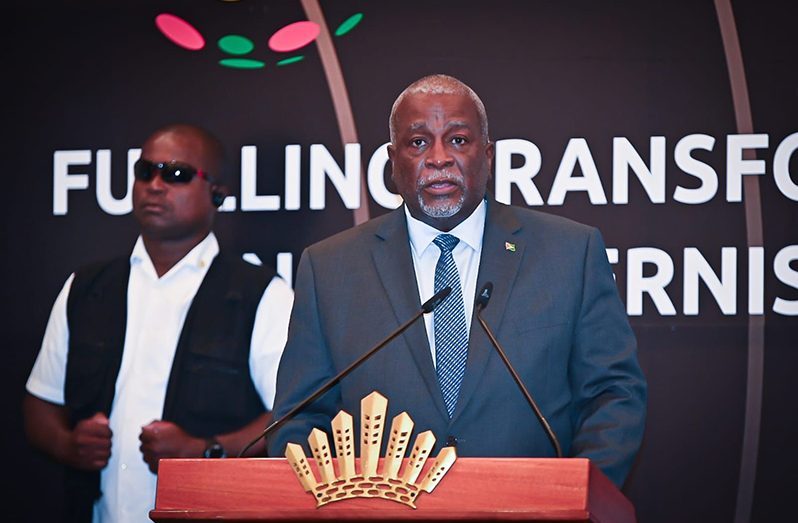– As Guyana advances in renewable energy, electricity access
THE country of Guyana has made remarkable advancements in its efforts to promote renewable energy, resulting in a substantial rise in electricity availability for the population living in remote areas. It is projected that, by 2025, almost 90 percent of the hinterland population will have access to electricity.
Prime Minister, Brigadier (Ret’d) Mark Phillips, revealed this information while speaking on the third day of the Guyana Energy Conference and Supply Chain Expo, held at the Marriott Hotel in Kingston.
With Guyana being heavily dependent on imported petroleum-based fuels for energy, Phillips, performing the duties of President, shared an extensive update with the audience on the nation’s strides in renewable energy and improved electricity access since 2022.
“The proportion of the hinterland population with reliable access to electricity has moved from 50 per cent to 66 per cent,” he said, while highlighting the People’s Progressive Party/Civic (PPP/C) government’s commitment to increasing that to 90 per cent by 2024, with the ultimate goal of full electricity coverage for the hinterland by 2025.
The Prime Minister outlined significant investments in solar energy, including “two utility-scale solar power farms and 31 solar mini-grids,” which have been pivotal in enhancing the nation’s renewable energy landscape.
The solar farm in Wakenaam, scheduled for completion in 2024, is a significant part of the extensive initiatives.
The mini-grid systems consist of off-grid solar photovoltaic (PV) systems that are equipped with battery energy storage. These systems are also connected to an electricity transmission and distribution network, which allows for the connection of public buildings in the communities.
PM Phillips believes that the project is proof of the government’s commitment to the low-carbon future described in the Low Carbon Development Strategy 2030. This strategy aims to transition from heavy fuel oil to natural gas as a temporary fuel source before fully embracing solar, hydropower, wind, and biomass.

The Guyana Utility Scale Solar Photovoltaic (GUYSOL) Programme, which is part of LCDS 2030, aims to invest in utility-scale solar systems to reduce the country’s dependence on fossil fuels and mitigate higher fuel prices.
This programme is expected to save the government millions of dollars in electric subsidies, which can be redirected to benefit the people.
The Prime Minister emphasised the significant improvements in solar power capacity nationwide and revealed that the government is making progress in establishing a 0.75 MW solar farm in Wakenaam, Region Three.
“Our renewable energy progress includes grid upgrades, rooftop and off-grid solar PV systems for public buildings, ICT Hubs, and agricultural facilities, accommodating an increase in solar capacity to more than 14 megawatts.”
Phillips also touched on the social impact of these initiatives adding that “These improvements include enhancing energy access in hinterland communities…”
He explained that the distribution of 30,000 solar photovoltaic systems to off-grid Hinterland and riverine households is nearly completed, benefitting approximately 140,000 persons in over 240 communities.
Each 160-watt system can power two nine-watt LED lamps, and one 12-watt stand fan, and is equipped with a USB port for charging portable electronic devices.
Additionally, the Prime Minister provided specific information about the financial commitments to these initiatives. He mentioned that a total of $95.7 billion has been earmarked in the 2024 National Budget for the energy sector.
According to him, this budget funds various projects such as adding more baseload capacity, the Gas-to-Energy project, the Amaila Falls Hydropower Project, and upgrading multiple substations and primary distribution networks.
He elaborated on future plans stating, “for 2024, continued works will seek to ensure that the proportion of the hinterland population with reliable access to electricity advances to 90%… including the completion of the 0.65 MW Mahdia solar farm and the commencement of a 10 MW solar farm in Berbice, an 8 MW solar farm in Essequibo, and a 0.6 MW solar farm in Leguan.”
Prime Minister Phillips painted an optimistic outlook for Guyana’s energy future, emphasising the government’s proactive stance in utilising renewable energy and ensuring equal access to electricity across the country.
The initiatives, he added, represent a significant leap towards sustainability and improved quality of life for all Guyanese, particularly those in remote areas.



.jpg)










